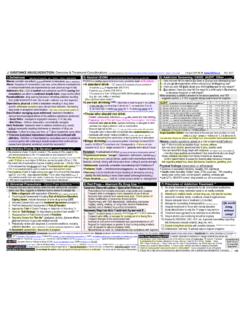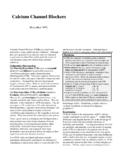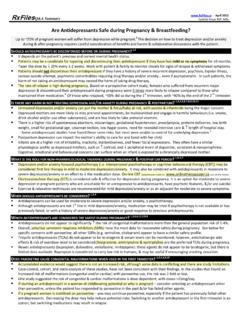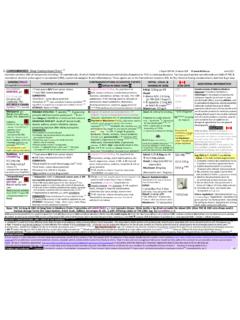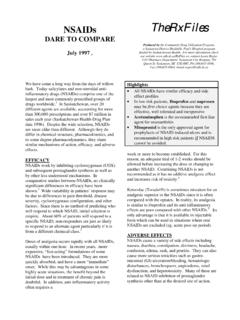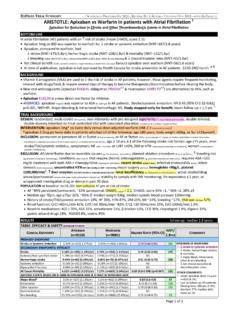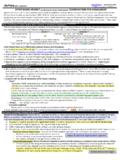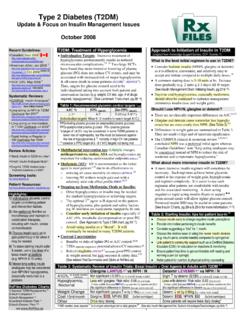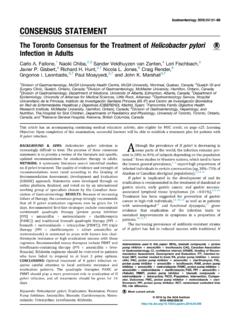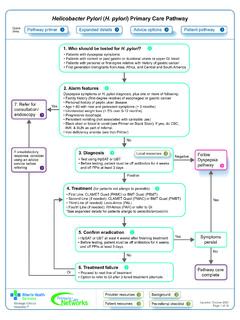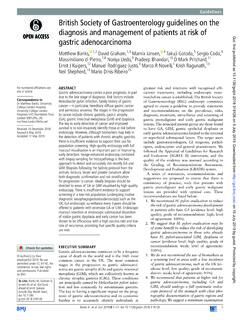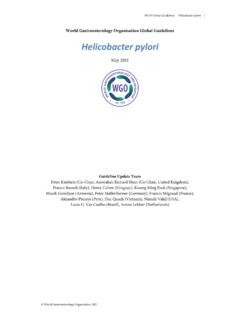Transcription of H. pylori Eradication Regimens - RxFiles
1 H. pylori Eradication Regimens 1-2-3 Cured March 1999. unequivocal duodenal or gastric ulcer, whether active or Highlights inactive, should receive Eradication treatment. Even if H. pylori Eradication drastically reduces ulcer NSAIDs are the suspected etiological agent, Eradication of recurrence in patients with duodenal or gastric ulcers. documented H. pylori infection is appropriate".4 The 7-day triple therapies with a proton pump inhibitor Consensus Conference discussed various other indications (PPI) + two antibiotics given BID are currently for H. pylori Eradication therapy and the reader is referred to recommended first-line for H. pylori Eradication the document for a complete discussion of this area. lansoprazole (or alternate PPI) + clarithromycin + either metronidazole or amoxicillin (see Table 3) H. pylori - Treatment Options A dose of clarithromycin 250mg po BID is preferred First-line Eradication Regimens achieve high rates of when using in combination with a PPI and both Eradication and patient compliance.
2 Two triple therapy metronidazole; however, the 500mg po BID dose is - 7 day Regimens are currently accepted as first-line therapy recommended in combination with a PPI + amoxicillin. (see Table 3).4 They combine a proton pump inhibitor (PPI). Maintenance acid suppression therapy is not necessary with either metronidazole and clarithromycin (Biaxin ), or following H. pylori Eradication except in high-risk amoxicillin and clarithromycin. These Regimens generally patients ( severe GI bleed; refractory ulcer disease). achieve Eradication rates of >80% on an intention-to-treat Ranitidine Bismuth Citrate or RBC (Pylorid ) is a new analysis (ITT) and >90% on a per-protocol analysis (PP). agent useful in H. pylori Eradication Regimens . Since non-compliance can drastically reduce Eradication rates, twice daily administration schedules are recommended. Background The approach is sometimes referred to as '1,2,3' - one week, helicobacter pylori is an important cause of duodenal and twice a day, with three medications.
3 Gastric ulcers. Greater than 90% of duodenal ulcers and 70%. Second-line Eradication Regimens include quadruple of gastric ulcers are associated with H. Eradication therapy with bismuth, metronidazole, and tetracycline plus of H. pylori is effective in healing ulcers and drastically either a PPI or an H2 receptor antagonist (H2RA) (see Table reducing the ulcer recurrence, eliminating the need for 3).4 If a PPI is chosen, the regimen can be given for 7 days;. maintenance however, if an H2RA is used, 14 days are recommended. H. pylori is a gram negative bacillus which colonizes in the Quadruple therapies are considered second-line because the gastric mucosa and causes an increase in gastrin release. H. Regimens require a more complex administration schedule pylori stimulates an inflammatory response involving the ( QID) and may be less well tolerated. Quadruple release of chemotactic cytokines such as therapies are therefore usually reserved for patients who have failed one or more courses of triple therapy.
4 4,5 Some Besides being a major etiological factor in peptic ulcer quadruple therapies are less costly and appropriate for disease (PUD), there is some evidence that it may also be patients in whom cost is a significant factor. associated with other gastric H. pylori is not easy to eradicate. Factors such as the bacterial resistance and Pylorid is a new drug which consists of ranitidine difficulty achieving bactericidal concentrations in the gastric bismuth citrate (RBC) 400mg. It may be useful in second- mucosa contribute to the variable response to antibiotic line triple therapy Regimens when combined with two therapy. As a result, triple and quadruple pharmacotherapy antibiotics (see Table 1). RBC was not included in Regimens are now used to ensure high Eradication rates. recommendations from the last Canadian Consensus Conference as it was not yet on the market. It has shown Indications for H. pylori Eradication similar efficacy to PPI's in 7 day - triple therapy Regimens The most recent Canadian H.
5 pylori Consensus Conference (see also Table 1). Further studies are awaited to verify recommends that "all H. pylori -positive patients with an efficacy compared to PPI-triple therapy Regimens . Considerations in Choosing a Regimen with bismuth subsalicylate (BSS) or clarithromycin, they are If the patient has a penicillin allergy, amoxicillin- often still highly effective even if H. pylori appears to be containing Regimens must be avoided. Amoxicillin Regimens metronidazole may also be less effective in patients pretreated with PPI' Primary resistance of H. pylori to clarithromycin is low If the patient has previously been on metronidazole, or is generally less than 2%.11,12 Acquired resistance can not willing to give up alcohol for the 7 day therapy, a non- approach 6%, reinforcing the recommendation to use triple metronidazole regimen may be preferred. rather than dual therapy. If cost is a significant concern, a low-cost regimen such as Is clarithromycin 250mg as good as 500mg in the PPI- RBC (Pylorid ) + metronidazole + tetracycline appears to triple based Regimens ?
6 Offer Eradication rates similar to first-line PPI triple therapy When used in combination with a PPI and metronidazole, at a cost of ~ $45 for 7-day therapy. (Although H. pylori clarithromycin should be given as 250mg po This is Eradication is expensive, it consistently results in lower costs supported by the MACH I Study which found that and better outcomes than H2RA maintenance ,7) Eradication rates were higher with the 250mg dose of If compliance is a major concern, the HP-Pack (see Table clarithromycin than they were with the 500mg dose (90%. 3) offers the advantage of a convenient blister card. Each versus 84% respectively).14 The lower dose is also better card provides one day's therapy, with morning and evening tolerated and less costly. dosing clearly indicated. When given with a PPI and amoxicillin, the current If a patient is on phenytoin, diazepam, warfarin, recommendations are to use 500mg clarithromycin po BID. theophylline or other drugs metabolized by CYP-2C9 or Whether this dose offers additional benefit is uncertain.
7 In CYP-2D6, pantoprazole (Pantoloc ) may be the preferred the MACH I study, the higher clarithromycin dose was PPI. Omeprazole is thought to be most likely, and superior to the low dose14; however, several studies have pantoprazole least likely, to have CYP450 related drug used doses of clarithromycin 250mg po BID while interactions, although the significance appears to be maintaining Eradication rates >85% ,16,17 Unless Clarithromycin has more significant potential for patient tolerance or cost are significant concerns, the 500mg drug interactions with various agents as listed in Table 2. mg dose of clarithromycin is recommended for PPI triple therapy with amoxicillin. Follow Up Acid Suppression Recurrence of ulcers following H. pylori Eradication are Is there any rational for selecting one PPI over another? uncommon. One prospective study which followed 141 Studies to date suggest that omeprazole 20mg BID, duodenal ulcer and 45 gastric ulcer patients for years lansoprazole 30mg BID, and pantoprazole 40mg BID have found no ulcer recurrence after H.
8 pylori Eradication in comparable efficacy in H. pylori ,16 ,18,19 Most patients not taking ASA or Thus, most patients controlled studies have used either omeprazole or do not require further acid suppression treatment lansoprazole. Currently, lansoprazole may be preferred. It following H. pylori Eradication . Additional short term acid has shown more potent inhibition of H. pylori urease suppression with PPI's or H2RA's may be indicated in activity,20 is generally less costly, and has less potential for symptomatic Complicated patients with large, or drug interactions than omeprazole. refractory ulcers, should receive acid suppression treatment What if a triple therapy fails? until ulcer healing and H. pylori Eradication can be Although routine documentation of H. pylori Eradication is In the case of gastric ulceration, follow-up is not recommended in uncomplicated ulcer patients, a important in ensuring complete ulcer healing, and excluding recurrence of ulcer symptoms warrants a reassessment of H.
9 The possibility of malignancy. Upon Eradication of H. pylori pylori Endoscopy and biopsy or a urea breath test and completion of ulcer healing, maintenance therapy is only may be performed at least four weeks after Eradication , and indicated in patients at high risk for recurrence of bleeding seven days after stopping acid suppressive ( need for continued ASA/NSAID therapy; high acid- Serologic assays are inappropriate as they remain high for secretory condition ). several months following successful Eradication . Related Questions Retreatment should usually be attempted with different What do we know about the relative efficacies of the antibiotics than were originally Resistance is various Eradication Regimens ? especially a concern with metronidazole and rarely with It is difficult to compare Eradication rates reported from clarithromycin. Alternative therapy with a quadruple different studies. There are many variables that can affect regimen ( PPI, BSS, metronidazole, and tetracycline) 11.
10 These rates. It has been suggested that the intention-to-treat or a triple regimen with RBC (Pylorid ) may be considered (ITT) rather than the per-protocol (PP) analysis should be (see Table 3). used as the primary Few definitive head to head Is classical triple therapy with bismuth, metronidazole studies have been performed, and given the relatively high and tetracycline still an option? Eradication rates currently achieved with triple therapies, This triple regimen was not recommended by the Canadian studies showing significant differences are unlikely. Consensus Conference because a meta-analysis showed that What are the rates of H. pylori resistance in Canada? on an ITT analysis, it had an Eradication rate of ~78%, below H. pylori resistance to metronidazole ranges from 11% to the arbitrary 80% cut-off 38%. However, when metronidazole is used in Regimens References available on request The Rx Files: H. pylori Eradication Supplementary Tables Table 1.
